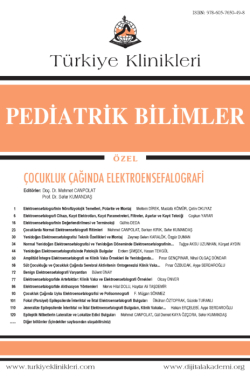Cerebral Ontogenesis During Infancy and Childhood Clinical Case and Electroencephalography Examples
Pınar ÖZBUDAKa, Ayşe SERDAROĞLUa
aÇocuk Nörolojisi BD, Gazi Üniversitesi Tıp Fakültesi, Ankara, TÜRKİYE
Özbudak P, Serdaroğlu A. Süt çocukluğu ve çocukluk çağında serebral aktivitenin ontogenezisi klinik vaka ve elektroensefalografi örnekleri. Canpolat M, Kumandaş S, editörler. Çocukluk Çağında Elektroensefalografi. 1. Baskı. Ankara: Türkiye Klinikleri; 2019. p.58- 71.
ABSTRACT
Changes in electroencephalogram are shaped by the structural and physiological state of the brain and sleep-wake cycles and varies in different age groups. From this point of view; variable EEG findings might be determined in different age groups as; newborn and premature, 2-12 months, 1-3 years, 3-5 years, 6-12 years and 13-20 years. In this review, EEG changes with respect to these age groups and sleep wake states are emphasized with particular examples.
Keywords: Electroencephalography; pediatricsÖzbudak P, Serdaroğlu A. Süt çocukluğu ve çocukluk çağında serebral aktivitenin ontogenezisi klinik vaka ve elektroensefalografi örnekleri. Canpolat M, Kumandaş S, editörler. Çocukluk Çağında Elektroensefalografi. 1. Baskı. Ankara: Türkiye Klinikleri; 2019. p.58- 71.
Kaynak Göster
Referanslar
- Britton JW, Frey LC. In: Erik K, ed. Electroencephalography (EEG): An Introductory Text and Atlas of Normal and Abnormal Findings in Adults, Children and Infants. Chicago: American Epilepsy Society; 2016. p.35-40.
- Hughes John R. EEG in Clinical Practice. 2nd ed. Boston: Butterworth-Heinemann; 1994. p.95-104.
- Carney PR, Andrage E, Geyer JD. EEG in the newborn, infant and adolescent. In: Greenfield LJ JR, Geyer JD, Carney PR, eds. Reading EEG's: A Practical Approach. Philadelphia: Lippincott-Williams & Wilkins; 2010. p.135-59.
- Niedermeyer E. Maturation of the EEG: development of waking and sleep patterns. Electroencephalography. Basic principles, clinical applications and related fields. 3rd ed. Baltimore: Williams & Wilkins; 1993. p.167- 91. [Crossref]
- American EEG Society recording Guidelines. Guideline II: minimum technical standarts for pediatric electroencephalography. J Clin Neurophysiology. 1986;3(2):139-43. [Crossref]

